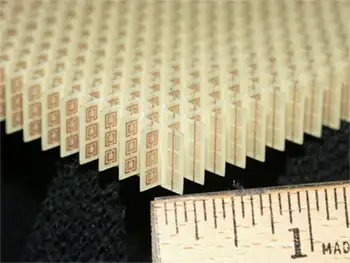In science and technology, there are moments when innovation transcends the boundaries of what was once thought impossible. Metamaterials, a groundbreaking field of material science, epitomize this notion. These extraordinary materials have captivated the imagination of researchers and engineers, promising to revolutionize industries ranging from telecommunications to healthcare. Explore, what are metamaterials, properties, and applications, including the Science of Invisibility.
Contents
What Are Metamaterials?
Metamaterials are a subset of functional materials, composite constructions made of common materials like metal and plastic that scientists have developed to have novel or improved qualities. They usually consist of a large number of organized individual components, or “meta-atoms.” These meta-atoms are far smaller than traditional optical components like lenses and prisms and are on the same size scale as the electronic circuitry of a computer chip. Metallic, semiconductor, and insulating nanostructures are the building blocks to create metamaterials, whereas nature builds materials using atoms. It has an extensive range of design options because there are virtually endless possibilities for nanostructures.
In other words, Metamaterials are a class of engineered materials with properties that cannot be found in nature. They are designed by arranging structural elements at a scale much smaller than the wavelength of the waves they interact with. This unique design allows metamaterials to manipulate electromagnetic waves, sound waves, or even thermal energy in unprecedented ways. The key to their remarkable capabilities lies in their microstructure, which grants them the power to control, redirect, and amplify waves as needed.
Extraordinary Properties of Metamaterials
Negative Refraction
One of the most striking properties of metamaterials is negative refraction, a phenomenon where light waves bend in the opposite direction compared to conventional materials. This property has significant implications for optics and imaging, enabling the creation of superlenses capable of capturing finer details than ever before.
Cloaking
Metamaterials have also sparked interest in the development of invisibility cloaks. By bending light around an object, metamaterials can render it invisible to certain wavelengths of light. While we’re not quite at the Harry Potter level of invisibility yet, metamaterials offer a tantalizing glimpse into the future of stealth technology.
Acoustic Manipulation
Beyond the realm of optics, metamaterials have found applications in acoustics. They can be designed to manipulate sound waves, creating sound barriers, perfect absorbers, and even devices that focus sound with extreme precision.
Applications in the Real World
Telecommunications
Metamaterials have the potential to revolutionize telecommunications. They can enhance signal transmission, improve antenna performance, and enable the development of ultra-thin, lightweight devices for wireless communication. This could lead to faster and more reliable internet connections and 5G networks.
Healthcare
In medicine, metamaterials can be employed to create susceptible imaging devices, such as MRI and CT scanners with unprecedented resolution. They could also be used to develop innovative medical devices for non-invasive treatments and surgeries, improving patient outcomes.
Energy
Metamaterials have the potential to transform the energy landscape. They can be used to design highly efficient solar panels, thermal insulators, and energy storage materials. By harnessing and controlling energy more effectively, we can move closer to a sustainable future.
Challenges and Future Prospects
While metamaterials hold immense promise, they also face several challenges, such as scalability, manufacturing costs, and the need for precise design. Researchers are actively working to overcome these obstacles, and as technology advances, we can expect to see more practical applications emerge.
Relationship Between Metamaterials and Nanotechnology
The relationship between metamaterials and nanotechnology is intertwined and essential to understanding the capabilities and applications of metamaterials. Here’s an exploration of how these two fields are closely related:
- Nanofabrication Techniques: Metamaterials are typically constructed by arranging sub-wavelength-sized structural elements in precise configurations. Nanotechnology provides the tools and techniques to manipulate matter at the nanoscale, enabling the fabrication of these intricate structures. Nanofabrication methods like electron beam lithography, focused ion beam milling, and chemical vapor deposition are commonly employed to create metamaterials.
- Size and Scale: The fundamental building blocks of metamaterials, often referred to as meta-atoms or unit cells, are usually designed at the nanoscale. These tiny structures interact with electromagnetic waves, sound waves, or other physical phenomena at a scale much smaller than the wavelengths involved. Nanotechnology allows for the precise control of these nanostructures to achieve the desired metamaterial properties.
- Tailored Properties: One of the key advantages of metamaterials is their ability to exhibit extraordinary and engineered properties. Nanotechnology plays a pivotal role in tailoring these properties. By adjusting the size, shape, orientation, and composition of nanostructures within metamaterials, researchers can fine-tune their behavior for specific applications.
- Broad Spectrum of Applications: The combination of metamaterials and nanotechnology has led to a wide range of practical applications. In optics, for example, nanoscale structures can be designed to manipulate light in unconventional ways, leading to advancements in lenses, cloaking devices, and photonic circuits. In acoustics, nanoscale structures can create materials that bend and control sound waves. These applications would be impossible without the precision of nanotechnology.
- Miniaturization and Efficiency: Nanotechnology allows for the miniaturization of metamaterial devices, making them smaller, lighter, and more efficient. This is particularly important in industries like telecommunications and electronics, where compact and high-performance components are desired.
- Multidisciplinary Collaboration: The synergy between metamaterials and nanotechnology often involves collaboration between experts in various fields, including physics, materials science, electrical engineering, and nanotechnology. This interdisciplinary approach has accelerated progress in both areas.
- Future Innovations: As nanotechnology continues to advance, it opens up new possibilities for designing and fabricating metamaterials with even more exotic and useful properties. These innovations have the potential to drive breakthroughs in fields such as energy harvesting, medical imaging, and information technology.
Nanotechnology is an indispensable tool for the creation and manipulation of metamaterials. The precise control and engineering of nanostructures enable metamaterials to exhibit unique properties and drive innovations across a wide range of applications. The close relationship between these two fields is likely to lead to further exciting discoveries and technological advancements in the future. To learn more about Nanotechnology read the below articles:
- Nanotechnology: Manipulating Atoms and Molecules
- Applications of Nanotechnology: Future Nanoscale Technology
- Nanotechnology in Future Warfare and Defense
Conclusion
Metamaterials are no longer confined to the realm of science fiction; they are a reality with the potential to reshape our world. With their extraordinary properties and wide-ranging applications, metamaterials are poised to drive innovation in fields as diverse as telecommunications, healthcare, and energy. As research continues to advance, we can anticipate a future where metamaterials and the Science of Invisibility play pivotal roles in addressing some of humanity’s most pressing challenges and unlocking new frontiers of possibility. In the not-so-distant future, we may find ourselves living in a world where the extraordinary becomes the every day, thanks to the transformative power of metamaterials.
Sources
- Kshetrimayum, Rakhesh S. “A brief intro to metamaterials.” IEEE Potentials 23.5 (2004): 44-46.
- Liu, Yongmin, and Xiang Zhang. “Metamaterials: a new frontier of science and technology.” Chemical Society Reviews 40.5 (2011): 2494-2507.
- Capolino, Filippo. Theory and phenomena of metamaterials. CRC Press, 2017.
- Cui, Tie Jun, David R. Smith, and Ruopeng Liu. Metamaterials. Boston, MA, USA: Springer, 2010.
- Kadic, Muamer, et al. “3D metamaterials.” Nature Reviews Physics 1.3 (2019): 198-210.
- Engheta, Nader, and Richard W. Ziolkowski, eds. Metamaterials: physics and engineering explorations. John Wiley & Sons, 2006.
FACT CHECK: We strive for accuracy and fairness. But if you see something that doesn’t look right, don’t hesitate to Contact us.
DISCLOSURE: This Article may contain affiliate links and Sponsored ads, to know more please read our Privacy Policy.
Stay Updated: Follow our WhatsApp Channel and Telegram Channel.













